Nearly two weeks ago, people of the Hindu faith celebrated the holiday of Diwali. At the end of next month, three celebrations will overlap as Christians will observe Christmas, Jews rejoice during Chanukah and African American culture is recognized during Kwanzaa. All have a central focus of different religions or cultures, yet lights are an instrumental part of each. This time of the year calls for us to come together, to better understand and support each other. To explain and explore the Lights of the Season, we asked local religious and cultural leaders for guidance, to share what the significance of lights are for their holiday and how we can all learn more and take part. A common theme is to honor triumph and help us find light in dark times.
The Celebration of Diwali (October 31st-November 1st)
By Dhawal Tank
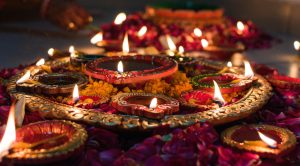 As the days grow shorter and the nights longer, people around the world come together to celebrate the festival of Diwali. For Hindus, Diwali is so much more than just a holiday – it is a sacred time to honor the triumph of good over evil, light over darkness, and knowledge over ignorance.
As the days grow shorter and the nights longer, people around the world come together to celebrate the festival of Diwali. For Hindus, Diwali is so much more than just a holiday – it is a sacred time to honor the triumph of good over evil, light over darkness, and knowledge over ignorance.
At the heart of Diwali is the story of Rama, an Avatar of God. Born as a prince, he was exiled to the forest for 14 years. During this time, Rama defeated the evil king Ravana before returning to the kingdom of Ayodhya. The people of Ayodhya celebrated Rama’s homecoming by lighting rows of clay lamps called diyas, illuminating the darkness. This tradition of lighting lamps is a key part of Diwali celebrations to this day.
The lights of Diwali welcome the Divine into our lives. Just as Rama conquered Ravana, the lights of Diwali remind us that with steadfast faith and virtue, we too can overcome the “ravanas” in our own lives – our weaknesses, fears and ignorance.
This is why people visit BAPS Swaminarayan Akshardham in Robbinsville, NJ. In presence of the sacred images of Bhagwan Shri Swaminarayan, Shri Ram, and the other great Avatars, they experience the presence of the Divine here. In the presence of these sacred images amid the Diwali festival, seekers find this light ignited in them.
It has always been the experience of Hindus that God is never far away from us. The Divine manifests here in every age for every devotee and aspirant. Through the sacred images at BAPS Swaminarayan Akshardham and through the God-realized guru, devotees experience the presence of the Divine.
When you enter BAPS Swaminarayan Akshardham, you aren’t just learning about the past. You are connecting with the Divine in the here and now. The intricate carvings, the sacred images, and the powerful presence of our guru His Holiness Mahant Swami Maharaj – these all make the stories of Diwali and the avatars like Rama feel alive and real.
Just as the lamps of Diwali are lit to welcome the divine, the BAPS Swaminarayan Akshardham complex stands as a beacon, illuminating the spiritual wisdom of Hinduism for all who visit.
Diwali is not just a holiday, it’s a lived experience. It’s about defeating the darkness in our own lives through faith, good deeds and the grace of the divine. That’s what BAPS Swaminarayan Akshardham allows us to celebrate every day.
As communities across New Jersey and around the world light diyas to honor Diwali, the message is clear: the light of knowledge, faith and virtue will always dispel the darkness. This is the timeless essence of Diwali.
The Celebration of Christmas (December 25th)
By Pastor Tracy Troxel
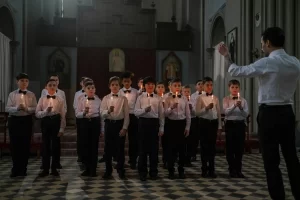 As a six-year-old boy I found religious services too passive. I craved activity and movement. The Christmas Eve service provided all of that including a little danger. Why? Because at the end of the Christmas Eve service every single person lit a candle and held that lit candle for minutes while we all sang a Christmas Carol together. Lighting a fire in church stirred my imagination.
As a six-year-old boy I found religious services too passive. I craved activity and movement. The Christmas Eve service provided all of that including a little danger. Why? Because at the end of the Christmas Eve service every single person lit a candle and held that lit candle for minutes while we all sang a Christmas Carol together. Lighting a fire in church stirred my imagination.
It took me years to understand why light is such an important picture of the true meaning of Christmas. The story of Christmas starts with the fact that the world has experienced profound darkness. Brokenness is a good description of the world we inhabit. We all understand that the world does not work very well at times. The first Christmas as described in the first gospel story tells us that “The people dwelling in darkness have seen a great light, and for those dwelling in the region and shadow of death, on them a light has dawned.” That light is Jesus. He came to bring light into a darkened world filled with brokenness and death.
In the fourth gospel story Jesus identifies himself as the light of the world. He came to dispel darkness and death. His entrance into the world on that first Christmas heralded the good news that the darkness of this world would not last forever. Jesus would lay down his life to defeat death and remove the darkness of this world and the darkness in our own hearts.
Interestingly, Jesus tells the followers of Jesus that “You are the light of the world.” This means that we are to help to dispel the darkness of the world. And the only way to repair the brokenness of the world is to follow in the way of Jesus: we must lay down our lives for others. Our time and financial resources must be poured out for others so that light can penetrate this shadowy world.
So, no matter what your faith commitments are, may I encourage you to spend time looking at the Christmas lights. You can attend the lighting of the tree in Palmer Square on November 29th at 5pm. Most churches in Princeton will have Christmas Eve services where candles are lit. Stone Hill Church has its services at 6pm on Christmas Eve. As you look at the Christmas lights may you contemplate the brokenness of this world while at the same time remember the model that Jesus showed us. His sacrifice leads to light. This motivates us to make sacrifices so that this shadowy world receives the much-needed light.
The Celebration of Chanukah (or Hannukkah) (December 25th – January 2nd)
By Rabbi Benjamin Adler
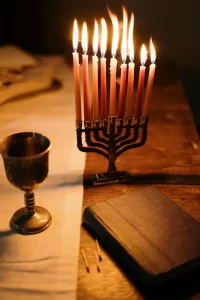 Chanukah is celebrated every year on the 25th day of the Hebrew month of Kislev, which corresponds this year to December 25. The holiday celebrates the victory over the Seleucid emperor Antiochus IV, who, as the ruler of the land of Israel, had persecuted the Jews and prevented them from following their religious laws. A group of Jewish rebels called the Maccabees rose up against this oppression and defeated the Seleucid rulers, leading to a period of Jewish independence in the land of Israel under the Hasmonean dynasty over 2,000 years ago.
Chanukah is celebrated every year on the 25th day of the Hebrew month of Kislev, which corresponds this year to December 25. The holiday celebrates the victory over the Seleucid emperor Antiochus IV, who, as the ruler of the land of Israel, had persecuted the Jews and prevented them from following their religious laws. A group of Jewish rebels called the Maccabees rose up against this oppression and defeated the Seleucid rulers, leading to a period of Jewish independence in the land of Israel under the Hasmonean dynasty over 2,000 years ago.
When the Maccabees gained control of the holiest site in Judaism, the Temple in Jerusalem, they found it desecrated. After restoring the Temple to its former glory, they rededicated the holy space, which is why the holiday is called Chanukah, a Hebrew word that means “dedication”. According to the Talmud, the most important ancient Jewish text after the Bible, the Maccabees found only one jar of pure oil to keep the menorah, a seven branched candelabra, lit in the Temple, as the Torah instructed. A miracle occurred, however, and the oil lasted for 8 days until more could be processed. Hence, the holiday is celebrated for 8 days with the lighting each night of a menorah.
Chanukah occurs during some of the longest nights of the year, so the kindling of the menorah is one way for Jews to bring the light of hope to such a dark time. Tradition encourages us to publicize the miracle of Chanukah by placing the menorah outside in the doorway or in a window for others to see. The light is meant to be shared. In addition to the menorah, celebrants sing Chanukah songs and play the game of dreidel, a spinning top, with gelt, chocolate in the shape of coins. It is also traditional to eat foods cooked in oil to recall the miracle in the Temple. Some favorites are latkes, potato pancakes, and sufganiyot, jelled-filled donuts.
The Festival of Lights, as Chanukah is known, is often celebrated at home each night of the holiday with a family menorah lighting and the exchange of presents, but there are also lots of ways to mark the occasion in public. Communities often have large menorah lightings outdoors and Chanukah parties. My synagogue, Adath Israel Congregation, in Lawrenceville, will be holding a Chanukah party for young children and their families on Sunday, December 15 at 9:30am. Kids will enjoy latkes, crafts, music, and other treats. In addition, Jews get together for special Chanukah themed Shabbat services during the holiday season. Adath Israel will host a special Shabbat in the Round service on Friday, December 20 at 7:30pm, led by our special musical leader Rory Michelle Sullivan. All are invited to both programs. There are many ways to celebrate the joyous and special holiday of Chanukah and help bring more freedom and light into the world.
The Celebration of Kwanzaa (December 26th – January 1st)
By Andrea Norcott
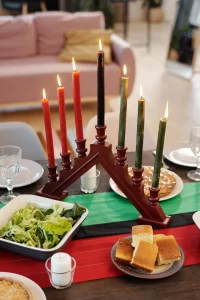 Kwanzaa is an African American holiday which commences the day after Christmas and is cele- brated for seven days. Each day of Kwanzaa is set aside to honor seven principles. We do this by lighting a candle each day to focus on these seven principles, encourage reflection, and en- courage discussion of each. The first day represents Umoja (Unity), demonstrating our resolve to create and maintain family unity. Day number two is Kujichagulia (Self-determination), defin- ing who we are, speaking greatness into ourselves, and being responsible for our actions. The third day is our commitment to working together to build our community, which is called Ujima (Collective Work and Responsibility). On the fourth day, Ujamaa (Cooperative Economics), we light a candle representing our commitment to building and supporting businesses in our communities. Day five is to reflect on our responsibility and persistence to remember and restore the greatness of our community and our collective goal, which is called Nia (Purpose). On the sixth day, we practice Kuumba (Creativity) to leave our community more beautiful than we found it. We light a candle on the seventh and final day to demonstrate Imani (Faith) in our people and community.
Kwanzaa is an African American holiday which commences the day after Christmas and is cele- brated for seven days. Each day of Kwanzaa is set aside to honor seven principles. We do this by lighting a candle each day to focus on these seven principles, encourage reflection, and en- courage discussion of each. The first day represents Umoja (Unity), demonstrating our resolve to create and maintain family unity. Day number two is Kujichagulia (Self-determination), defin- ing who we are, speaking greatness into ourselves, and being responsible for our actions. The third day is our commitment to working together to build our community, which is called Ujima (Collective Work and Responsibility). On the fourth day, Ujamaa (Cooperative Economics), we light a candle representing our commitment to building and supporting businesses in our communities. Day five is to reflect on our responsibility and persistence to remember and restore the greatness of our community and our collective goal, which is called Nia (Purpose). On the sixth day, we practice Kuumba (Creativity) to leave our community more beautiful than we found it. We light a candle on the seventh and final day to demonstrate Imani (Faith) in our people and community.
Kwanzaa was primarily celebrated by African Americans when it was first established. How- ever, it is currently celebrated by other parts of the diaspora, such as Jamaica, where I am
from. Kwanzaa candle lighting ceremonies are typically hosted by local African American or- ganizations, but some city halls also participate in the Kwanzaa candle lighting ceremonies. Ad- ditionally, some families share these traditions via social media live streams.
You can celebrate Kwanzaa with the Smith Family Foundation, on Thursday, December 26, at Trenton City Hall, from 4:30 PM to 6:30 PM and on Friday, December 27, at Mercer Museum & Fonthill Castle from 4:00 to 6:00 PM.
I hope this holiday season greets each of us, whatever holiday we celebrate, with a sense of unity, self-determination, a sense of responsibility for one another, a measure of resources to give back, resolve to restore and beautify our communities, and finally to have faith in ourselves and our communities.
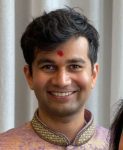
Dhawal Tank is a youth volunteer for BAPS. He currently resides in Dallas, TX and works as a marketing consultant. BAPS Shri Swaminarayan Mandir is in Robbinsville, NJ.
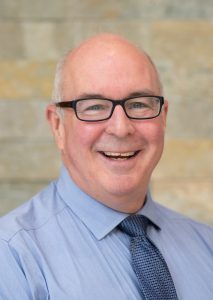
Tracy Troxel has served at Stone Hill Church in Princeton for 24 years. He is married to Denise, and they have 3 grown children.

Rabbi Benjamin Adler, the spiritual leader of Adath Israel Congregation in Lawrenceville, New Jersey, is a graduate of the Jewish Theological Seminary of America in New York City. Rabbi Adler has served congregations in Rockaway, New Jersey, Pittsfield, Massachusetts and Greenport, New York.

Andrea Norcott is a dedicated leader with over 20 years of experience at the New Jersey Department of Labor. Outside of her professional role, Andrea is deeply invested in her community as a board member of the African American Cultural Collaborative of Mercer County. Serving as both the Outreach Coordinator and Literacy Chair, she represents the organization at events, maintains strong relationships with local business owners and government leaders, and helps plan initiatives that support community engagement. Andrea collaborates closely with educational entities and literacy programs, actively working to create and promote opportunities that enrich the community through literacy and cultural awareness.
